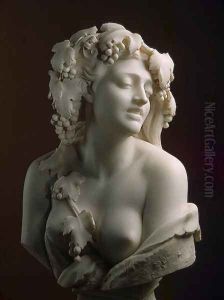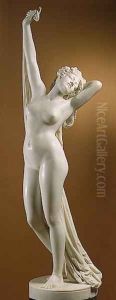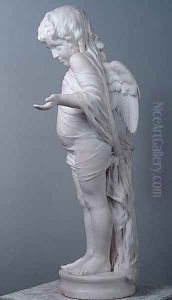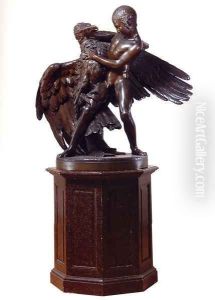Prosper d'Epinay Paintings
Prosper d'Epinay, a Mauritian-born sculptor of French descent, played a significant role in the art world of the 19th century. He was born on October 13, 1836, in Mauritius, a small island in the Indian Ocean that was then a French colony. Coming from an aristocratic family, d'Epinay had the opportunity to pursue his interests in the arts from a young age.
D'Epinay initially studied law in Paris, but he soon abandoned this path to focus on sculpture. He trained under renowned sculptor Augustin-Alexandre Dumont, and as his skills developed, he began to gain recognition for his work. D'Epinay's sculptures often reflected the neoclassical style popular at the time, characterized by its emphasis on harmony, clarity, and restraint. His works typically depicted historical and mythological figures, with an attention to ideal beauty and form that was typical of the era's artistic sensibilities.
During his career, Prosper d'Epinay became particularly well-known for his portrait busts and statues. He created works for various notable figures of his time, including members of European nobility and other prominent individuals. One of his most famous works is the bust of Ludwig II of Bavaria, which exemplifies his skill in capturing not just the physical likeness but also the personality and spirit of his subjects.
D'Epinay's work was widely exhibited, including at the Paris Salon, where he received critical acclaim. His sculptures were also shown internationally, enhancing his reputation beyond France. D'Epinay was awarded several honors, such as the Legion of Honour, which further solidified his status as a respected artist.
Prosper d'Epinay's legacy is not limited to his sculptures; he is also remembered for his contributions to the artistic community. He was a member of the Société des Artistes Français and was actively involved in the cultural life of Paris. His influence extended to his role as a mentor to younger artists, helping to shape the next generation of sculptors.
D'Epinay spent the latter part of his life in France, where he continued to work and create art until his death on April 20, 1914. His works can still be found in museums and private collections around the world, serving as a testament to his skill and the enduring appeal of neoclassical sculpture. Prosper d'Epinay's artistic vision and technical mastery have ensured that he remains a respected figure in the history of art.



